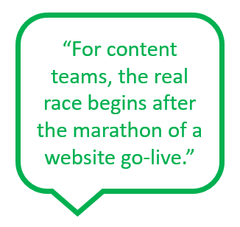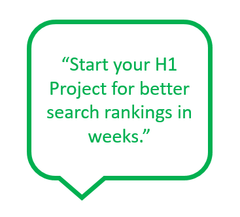 Producing a big website is like running a marathon, culminating in a frantic sprint over the finish line. Business-as-usual slowly returns and change requests come in. At first, you’re thankful for the quieter pace. But after the mad dash of go-live, it is easy to forget that the real race begins — that is, the race to top search rankings and engage customers.
Producing a big website is like running a marathon, culminating in a frantic sprint over the finish line. Business-as-usual slowly returns and change requests come in. At first, you’re thankful for the quieter pace. But after the mad dash of go-live, it is easy to forget that the real race begins — that is, the race to top search rankings and engage customers.
After go-live, a clear content strategy can give way to a list of change requests
You and your content-creating colleagues diligently move from work request to work request. After some time, your days begin to look similar. You’re still busy, but you’re running in circles. Your team seems to have no clear content strategy, KPIs, budget, regular thanks or praise. You secretly long for more collaboration, purpose and impact.
If any of this sounds familiar, then this — content creators — is a good time to start your H1 Project.
The H1 Project is cross training for content teams
If there’s one high impact but doable task, I advise digital content teams to take on, it is starting their very own H1 Project.
Here’s why.
Headlines are probably the most important piece of content on a web page, yet badly written headlines are everywhere. That's good news for content writers looking for a competitive edge.
 Research shows most people read headlines, even if they read nothing else. They judge a web page, blog or newsletter by its main headline. So headlines dramatically influence usability and customer engagement. Behind the scenes, an effective headline acts as powerful data that influences search results and search rankings.
Research shows most people read headlines, even if they read nothing else. They judge a web page, blog or newsletter by its main headline. So headlines dramatically influence usability and customer engagement. Behind the scenes, an effective headline acts as powerful data that influences search results and search rankings.
The H1 Project delivers many benefits — fast
The H1 Project has the single objective of improving page headlines on your website. Although the objective is narrow, the benefits are manifold: better page usability, better search results, better search rankings, a better understanding of your web content as a whole.
And there are other surprising benefits: meaningful collaborative work for your team without the pressures of go-live and the need for project budget or executive sign-off.
 If you manage a small website, your H1 Project will deliver benefits within a few short weeks. If your website has hundreds of pages, you could see benefits within 12-16 weeks. So here’s how you can start your H1 Project. There is a bit of legwork, but then your H1 Project will be up and running.
If you manage a small website, your H1 Project will deliver benefits within a few short weeks. If your website has hundreds of pages, you could see benefits within 12-16 weeks. So here’s how you can start your H1 Project. There is a bit of legwork, but then your H1 Project will be up and running.
Step 1: Scope your H1 Project
First, size up your project. How many content pages does your site have? Look at your analytics to determine which pages are most visited. Identify the 20% of pages that appeal to 80% of your target audience.
Step 2: Create a simple schedule
If your website is large, the H1 Project is best run as a relay race: divvy up your pages among your team. This will unite your team around a collective goal. At the same time, you will all refresh your SEO copywriting skills. And share what would be a menial and dry task for one person alone.
So if you have 1000 web pages, and 3 team members tackling 5 headlines per day, your H1 Project will take 3 months. Create a schedule and stick to it.
You can download and use the simple schedule and tracking spreadsheet below.
Step 3: Agree to standards
Agree on a standard for your new H1 headlines. The perfect headline is:
- 4-10 words long, like a news headline
- a clear guide to the reader about the page's contents
- unique and specific (literally the only page with that headline)
- sprinkled with relevant keywords
- active and positive.
Step 4: Do a trial run
Together as a team, create a few exemplar headlines for your most visited pages. Publish them and test out how they look on various devices.
Step 5: Research keywords
Using a keyword planning tool, research keywords for your website as a whole. Research the best 1-2 keyword phrases for each major topic area. You’ll need both types of keyword phrases. Put these into your spreadsheet for your team to use.
Step 6: Benchmark before you start
Benchmarking is important: It allows your team to look back and see how far you've come. It brings meaning to your work and it enables executive teams to appreciate your impact.
For your keyword combinations, see where your pages rank right now on popular search engines. Record these rankings on your spreadsheet.
Step 7: Tackle several headlines each day
Systematically improve each H1 headline, following your time schedule. Read each page and write a headline that captures the topic of the page. Include the main keyword phrase for that topic.
In your spreadsheet, it pays to take note of which pages seem to be full of ROT (Redundant, Outdated and Trivial content). This cleverly turns your H1 Project into a content audit, that should inform your future content goals.
Step 8: Recycle headlines for title tags
Then add the same H1 text to each page’s title tag. This brilliant trick is vital for improving your search engine rankings.
Step 9: Track and celebrate progress
Check your search rankings 5-10 weeks after your H1 Project is done. (It takes time for search engines to index new content).
By then, I expect your team's spirits and your website rankings will both be running high.
- Download this simple spreadsheet for your H1 Project
- Brush up on your digital content skills for your H1 Project
- Ask us a question about how to start your H1 Project
#contentstrategy #contentwriting #SEO #usability #UX #contentdesign #digitalcontent #contentmarketing #copywriting #SEOcopywriting

Leave a comment: